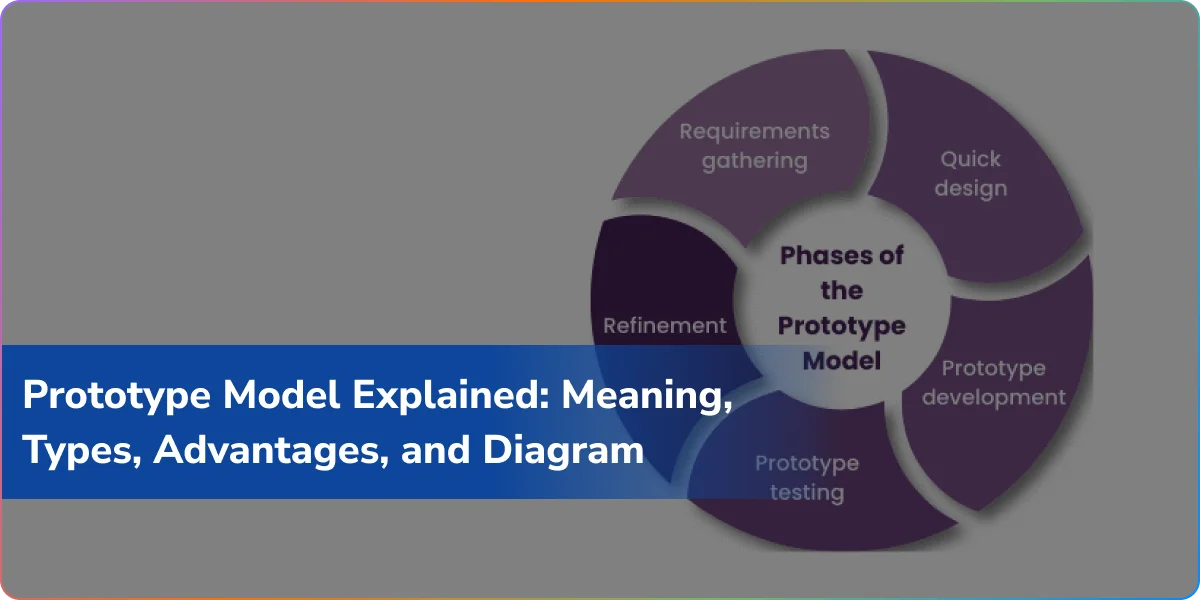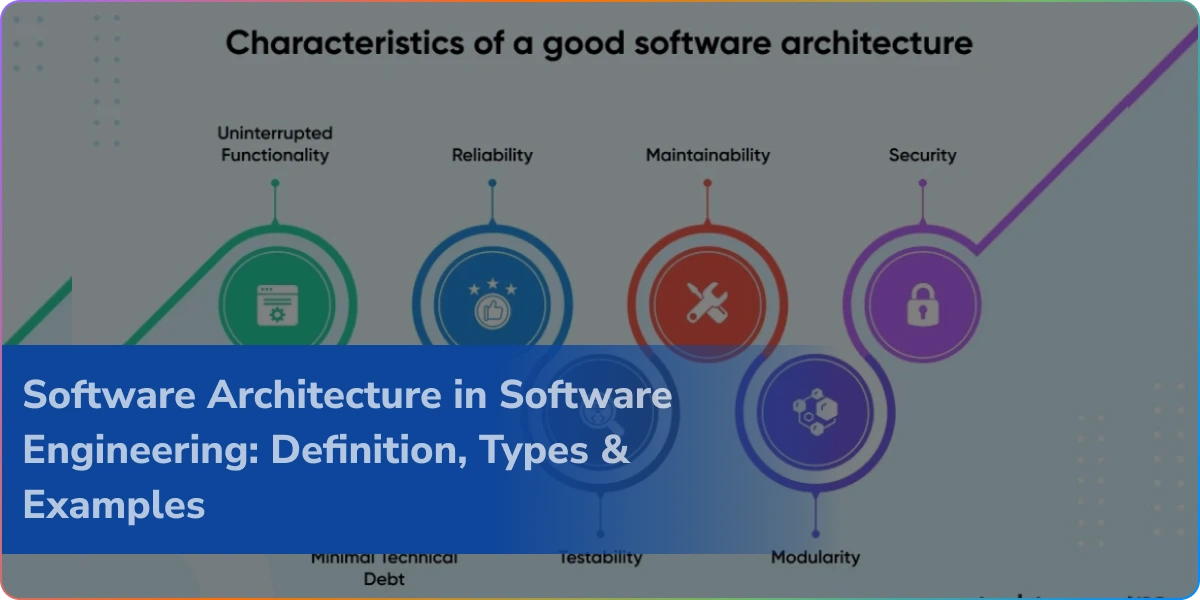In software development, catching the user requirements early can make or break the project. This is where the prototype model comes in. By using this model, developers and clients can view the ultimate shape and behavior of the system and determine whether it is what they need before the actual development occurs.
In this blog, we’re going to explain prototype model, what is prototyping model, its types, advantages, and even walk you through a prototype model diagram so that you have an idea of how it goes in real software development.
What is Prototype Model in Software Engineering?
The prototype approach in computer science is a software development methodology where the first version of the software, a prototype, is built, deployed, and recreated repeatedly until the final system meets user requirements.
Instead of determining all the requirements at the very beginning (like in the Waterfall Model), the prototype model is based on the creation of a quick, functional model accessible for users. Depending on their feedback, the requirements and the design are then fine-tuned.
In simple terms, if you’re wondering what is prototype in software engineering, it refers to a rough version or mock-up of the final software that helps developers and users visualize the product and make improvements early in the process.
Why Apply the Prototype Model?
Prototype model is especially useful when requirements are poorly understood or the project is complicated. In such a scenario, it is difficult for users to define exactly what they need. By creating a prototype, developers can demonstrate functionality, gather feedback, and make required changes prior to starting the final development.
This constant interaction between developers and clients ensures that the end software comes out as desired and avoids costly errors later in the project timeline.
Stages of the Prototype Model
To make the prototype model easier to understand, let’s go through its typical stages:
- Requirement Identification:
Client-provided initial system requirements are collected. They are typically incomplete but sufficient to start the first design.
- Develop Initial Prototype:
A starting, working model (typically a UI or limited functionality demonstration) is built using available tools. It enables visualization regarding how the system might function.
- User Evaluation:
The user or the client interacts with the prototype and gives feedback regarding the design, functionality, and flow.
- Refinement:
The prototype is improved, and new iterations are made based on the feedback.
This cycle is repeated until the users are content.
- Final Product Development:
After the prototype is accepted, the final system is created based on the improved requirements.
- Testing and Maintenance:
The final system is tested, deployed, and supported afterward.
This cycle executes repeatedly until there is mutual agreement of users and developers regarding the functionality and product design.
Prototype Model Diagram
For a better understanding of how this process works, here is a simple prototype model diagram:
Requirements Gathering
↓
Quick Design
↓
Build Prototype
↓
User Evaluation
↓
Refinement of Prototype
↓
Final System Development
↓
Testing & Implementation
This prototype model diagram easily shows the feedback loop between users and developers in an iterative manner to make sure that the final software aligns with user needs.
Types of Prototyping
There are different types of prototyping in software development, and each one is suitable for diverse project requirements. Let’s talk about the important ones:
1. Throwaway or Rapid Prototyping
Close-ended prototyping is another name for this one. Its primary goal is to create an easy functional model quickly to receive feedback.
Upon receiving feedback, the prototype is discarded, and the real system is created based on clear requirements.
Best suited for: Projects with unclear or changing requirements.
2. Evolutionary Prototyping
Evolutionary prototyping is the process of continuously refining the prototype until it becomes the final product upon delivery. Each iteration adds new features based on customer feedback.
Appropriate for: Systems that need to be updated and enhanced regularly.
3. Incremental Prototyping
Here, multiple prototypes are developed for different components or modules of the system. These are integrated to create the final product.
Best suited for: Large systems developed in modules or segments.
4. Extreme Prototyping
A method mostly used in web applications, extreme prototyping consists of three phases—static page development, functional screens, and backend integration of services.
Best suited for: Web applications where user interfaces and interactions are of major importance.
5. Operational Prototyping
This technique involves constructing operational prototypes initially and then refining them progressively. Users can work with these systems while incrementally adding new features.
Best for: Projects that are long-term in nature with frequent updates and refinement.
Prototype Model Example
Let’s take a prototype model example to understand it better.
Assume a client wants a customized e-commerce website but doesn’t know anything about how checkout and shopping cart will be done.
Using the prototype model, the development team would initially create a rough draft showing:
- Homepage layout
- Product list layout
- Add-to-cart and checkout mechanism
The client collaborates on this first prototype and provides feedback — maybe the checkout is too slow, or the cart button isn’t prominent enough.
The development team refines the prototype, making the design more usable through feedback. After several rounds, when the client is satisfied, the ultimate e-commerce site is constructed from the approved design and flow.
This prototype model example illustrates how iterative testing and preliminary visualization help in creating user-accepted software successfully.
Limitations of Prototype Model
Although it is beneficial, the prototype model also has some drawbacks that must be considered by developers:
- Time-Consuming: Repeated feedback loops and iteration may extend the timeline.
- Costly for Large Projects: Developing several prototypes can increase expenditure if not managed.
- Misunderstanding of Scope: Users can get confused between the prototype and final product, setting unrealistic expectations.
- Repeated Requirement Changes: Constant changes can sometimes disturb original project flow.
Effective communication, proper documentation, and a sound scope are the solutions to this challenge.
When to Use the Prototype Model
The prototype model of software engineering is ideally suited when:
- Requirements are uncertain or changing.
- The user interface (UI) is critical to the system.
- Extended client interaction is a requirement for the project.
- Ongoing feedback loops are required to test hypotheses.
Models like fintech, e-commerce, healthcare, and edtech commonly employ this model to develop user-centric solutions.
Difference Between Prototype Model and Waterfall Model
| Aspect | Prototype Model | Waterfall Model |
| Approach | Iterative and feedback-based | Sequential and phase-based |
| Flexibility | High – allows changes anytime | Low – changes are difficult once a phase is complete |
| User Involvement | Continuous | Limited |
| Risk of Misunderstanding | Low, as users test prototypes | High, due to late validation |
| Cost Efficiency | More efficient for evolving requirements | Better for fixed requirements |
This comparison highlights how the prototype model is more dynamic and user-oriented than traditional linear models like Waterfall.
Conclusion
The prototype model is the most effective approach in software development that provides transparency, user feedback, and reduced development risk. Understanding what is prototyping model, the types of prototyping, and the advantages of prototype model helps companies achieve improved results and user satisfaction.
We at Logixbuilt Solutions make your software concepts a reality with smart prototyping, hassle-free development, and confident delivery.
Work with Logixbuilt Solutions and turn your dreams into reality with innovative and user-driven software.
FAQ’s
1. What is Prototype Model in Software Engineering?
The prototype model in software engineering is a development method where a working model of the software, a prototype, is produced, tested, and refined on the basis of user feedback before building the ultimate system. It helps in the comprehension of user requirements and the reduction of risk early on.
2.What is Prototype in Software Engineering?
A prototype in software development is a preliminary, reduced version of the software that illustrates the general functionality and look of the software. It allows users and developers to visualize how the end product will function and make essential changes before mass development.
3. What are the Types of Prototyping?
There are many different prototypes, including throwaway (rapid), evolutionary, incremental, extreme, and operational prototyping. Each serves a particular purpose depending on project complexity, time constraints, and user interaction.
4. What are the Advantages of Prototype Model?
Early identification of errors, followed by enhanced clarity of requirements, improved user satisfaction, more communication between developers and customers, and flexibility to bring about changes during development.
5. Can You Give an Example of a Prototype Model?
A prototype model example would be making a mock-up of an online shopping site. The initial prototype would have generic pages, products, and a shopping cart. The team then refines the design further based on user feedback until the client provides approval, prior to building the final product.



